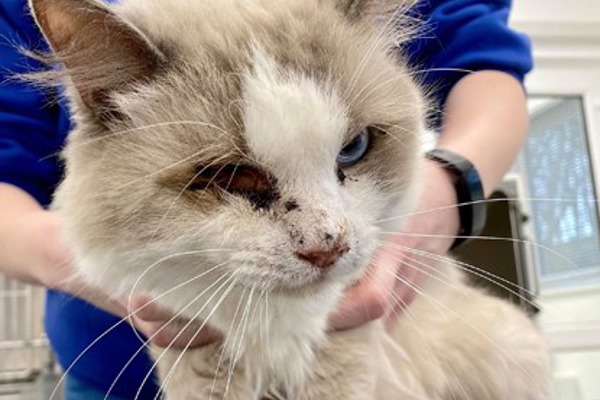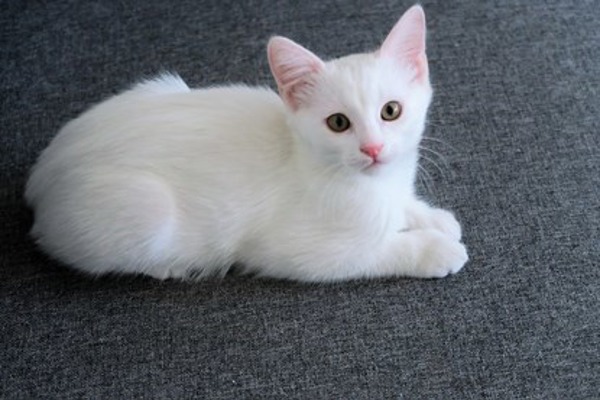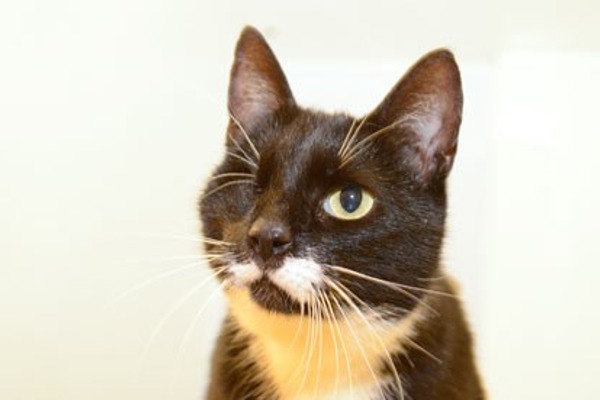How to look after a cat with a disability such as loss of sight, loss of hearing, cerebellar hypoplasia or physical impairment.
Our Caithness Branch recently raised the funds for 10-year-old Wally to undergo a vital operation on an ear infection he picked up while he was living on the streets. The procedure was a complete success but it did leave him deaf. Now fully-recovered, Wally has a lovely home with owners who can cater to his needs, on a farm with a view overlooking the sea. But just how differently do we need to treat cats with disabilities?
The truth is, whether they were born with a disability or developed one later in life as a result of an accident, disease or old age, cats are very good at adapting their lifestyles to cope with their new circumstances.
Along with losing their hearing and sight, cats’ mobility can also suffer, either from the lack of a limb or from conditions such as cerebellar hypoplasia which can cause uncoordinated movement. Here are a few suggestions on how to look after cats with these disabilities.
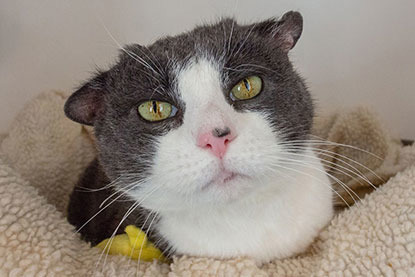
Despite losing his hearing, Wally is now enjoying a happy life. Photo by CP Caithness Branch
Deaf cats
Like humans, many cats gradually lose their hearing as they get older. Others are born deaf or suffer hearing loss suddenly as a result of illness or injury. Deaf cats can compensate for their lack of hearing so well that it’s sometimes difficult to tell they have a disability.
- For their own safety, it’s recommended that deaf cats are not allowed outside, unless it’s in a run or securely fenced garden. For more information on how to look after indoor cats, see our caring for indoor cats blog post
- In case they do get lost, they will need to be easily identifiable. Like all cats, they should be microchipped and it may be prudent to fit them with a quick-release collar stating their address and disability
- It may be possible to call a deaf cat using visual cues, such as hand signals and torch flashes, as long as they are distinct and used consistently to mean the same thing
- To avoid startling a deaf cat, walk heavily when approaching them so they can sense the vibrations
Blind cats
Cats can be born with blindness, it can develop gradually or it can arrive suddenly as the result of a trauma or illness.
- As with deaf cats, blind cats should be microchipped, kept indoors and consideration should be given to fitting them with a quick-release collar stating their address and disability
- Be aware that cats that have experienced sudden blindness may choose to stay near their sleeping area and could develop inappropriate toileting habits because they can’t find the litter tray
- Try to avoid carrying blind cats. All cats have a natural ability to retrace their steps using scent glands on their paws and being lifted will disrupt that navigation
- Talk to your cat as you approach them to ensure they aren't startled by your presence
- Blind cats are reliant on scents and memories so avoid moving furniture, food and litter trays around as well as leaving obstacles in unexpected places
- If you have stairs, place a barrier across them until your cat learns where they are. Once they start using them again, consider laying differently-textured carpet on the top and bottom steps, so they know when they've reached them
- Playing with blind cats is a good way of ensuring they get enough exercise. Given their reliance on hearing, use toys that make noises
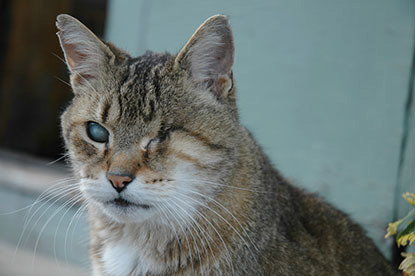
Blind cats are reliant on their other senses. Photo by Jeff-o-matic via flickr / Creative Commons
Cerebellar hypoplasia
Cerebellar hypoplasia is a condition that occurs in kittens as a result of interrupted development of the brain. It causes uncoordinated movement and those affected are often referred to as ‘wobbly kittens’.
- As with deaf and blind cats, it is recommended that cats with cerebellar hypoplasia should be kept indoors, microchipped and, ideally, fitted with a quick-release collar stating their address and disability
- They may benefit from a deep litter tray with high sides that they can use for support when toileting – just ensure they can access it
- Affected cats can create a mess when eating and drinking, so ensure the areas surrounding their bowls is easily cleaned and use a water bowl that isn’t easily turned over
- Ensure they can reach their favourite spots easily by using steps or ramps and consider strategically placing cushions and thick rugs under high areas they may frequent, just in case they fall or mistime a jump
- Keep their claws trimmed as they might find it difficult to unhook themselves if they get one caught in something
Three-legged cats
While it’s possible for cats to be born with three limbs, such a condition is usually the consequence of illness or injury. While getting around on three legs can take some getting used to, cats can usually adjust to the impediment remarkably well.
- As your cat gets used to the loss of a limb they should remain indoors with everything they need (eg sleeping areas, food, water, litter trays and scratching posts) within easy reach
- While they are learning how to balance on three legs, ensure they can’t access high surfaces from which they could fall
- Cats may take time to get used to completing everyday tasks like toileting and grooming. Consider improving litter tray access and help them groom areas they can’t reach (if they’re not used to being groomed, start slowly and ensure it’s a positive experience for them)
- Once they have the confidence to head outside, ensure they can get back inside easily and leave their litter tray in place – toileting can be a vulnerable experience for cats and they may feel safer doing it indoors
- It’s important they retain a healthy weight as extra load places more strain on each leg than it would in a four-legged cat and this can cause problems, such as arthritis, later in life
For more information on how to care for cats with disabilities, see our disabled cats guide.

